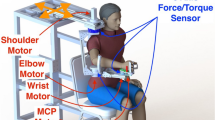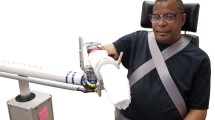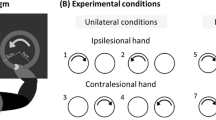Abstract
Among other diminished motor capabilities, survivors of a stroke often exhibit pathological joint synergies. With respect to the upper limbs, these deficits diminish coordination in reaching, pointing, and daily task performance. Past research on pathological synergies suggests that the synergistic relationship between joints is different for flexion than in extension. One explanation for different flexion and extension synergies is that there exists a time difference between the joint being volitionally moved and the joint that moves in synergy. The goal of this research was to measure these synergistic time differences. The experiment included 11 hemiparetic subjects who performed rhythmic elbow motions at five different frequencies. A motion capture system was used to record the resulting shoulder synergies. Synergistic shoulder rotations were found to exhibit frequency-dependent phase lags (delays) and leads (advances) in the paretic arm. Furthermore, the synergistic leads and lags varied with frequency and were subject specific. We found that timing differences between joints in pathological movements are comparable to differences that were observed by other researchers for normal, able-bodied movement synergies. Moreover, the fact that pathological synergies were evident in rhythmic motion suggests that they are spinal in origin. A significant amount research exists relating to able-bodied spinal synergies. Thus, the supposition that pathological synergies are an expression of normal synergies would tie disabled movement into a larger body of work related to able-bodied synergies. The rehabilitation implications of this possible connection are discussed.




Similar content being viewed by others
References
Archambault P, Pigeon P, Feldman AG, Levin MF (1999) Recruitment and sequencing of different degrees of freedom during pointing movements involving the trunk in healthy and hemiparetic subjects. Exp Brain Res 126:55–67
Behrman A, Bowden M, Nair P (2006) Neuroplasticity after spinal cord injury and training: an emerging paradigm shift in rehabilitation and walking recovery. Phys Ther 86:1406–1425
Bennett DJ, Hollerbach JM, Xu Y, Hunter IW (1992) Time-varying stiffness of the human elbow joint during cyclic voluntary movement. Exp Brain Res 88:433–442
Brunnstrom S (1970) Movement therapy in hemiplegia: a neurophysiological approach. Harper and Row, New York, pp 7–14
Chen XY, Wolpaw JR (2002) Probable corticospinal tract control of spinal cord plasticity in the rat. J Neurophysiol 877:645–652
Cheung VCK, d’Avella A, Tresch M, Bizzi E (2005) Central and sensory contributions to the activation and organization of muscle synergies during natural motor behaviors. J Neurosci 25(27):6419–6434
Cheung VCK, Piron L, Agostini M, Silvoni S, Turolla A, Bizzi E (2009) Stability of muscle synergy for voluntary actions after cortical stroke in humans. Proc Natl Acad Sci 106(46):19563–19568
Clark DJ, Ting LH, Zajac FE, Neptune RR, Kautz SA (2010) Merging of healthy motor modules predicts reduced locomotor performance and muscle coordination complexity post-stroke. J Neurophysiol 103:844–857
d’Avella A, Saltiel P, Bizzi E (2003) Combinations of muscle synergies in the construction of a natural motor behavior. Nat Neurosci 6(3):300–308
De Weerdt WJG, Harrison MA (1985) Measuring recovery of arm-hand function in stroke patients: a comparison of the Brunnstrom–Fugl–Meyer test and the Action Research Arm test. Physiother Can 37(2):65–70
Dietz V, Zijlstra W, Duysens J (1994) Human neuronal interlimb coordination during split-belt locomotion. Exp Brain Res 101:513–520
Dipietro L, Krebs H, Fasoli S, Volpe B, Stein J, Bever C, Hogan N (2007) Changing motor synergies in chronic stroke. J Neurophysiol 98(2):757–768
Duncan PW, Propst M, Nelson SG (1983) Reliability of the Fugl–Meyer assessment of sensorimotor recovery following cerebrovascular accident. Phys Ther 63(10):1606–1610
Edgerton R, Tillakaratne N, Bigbee A, de Leon R, Roy R (2005) Plasticity of the spinal neural circuitry after injury. Annu Rev Neruosci 27:145–167
Georgopoulos AP (1991) Higher order motor control. Annu Rev Neurosci 14:361–377
Georgopoulos AP, Schwartz AB, Kettner RE (1986) Neuronal population coding of movement direction. Science 233:1416–1419
Given JD, Dewald JP, Rymer WZ (1995) Joint dependent passive stiffness in paretic and contralateral limbs of spastic patients with hemiparetic stroke. J Neurol Neurosurg Psychiatry 59:271–279
Gizzi L, Feldbaek J, Felici F, Ivanenko Y, Farina D (2011) Impulses of activation but not motor modules are preserved in the locomotion of subacute stroke patients. J Neurophysiol 106:202–210
Grillner S (1981) Control of locomotion in bipeds, tetrapods, and fish. In: Brooks VB (ed) Handbook of physiology, sec 1, vol 2. Wiley, New York, pp 1179–1236
Ivanenko Y, Poppele R, Lacquaniti F (2006) Motor control programs and walking. Neuroscientist 12:339
Johansson B (2000) Brain plasticity and stroke rehabilitation: the Willis lecture. Stroke 31:223–230
Kargo WJ, Giszter SF (2000) Afferent roles in hindlimb wipe-reflex trajectories: free-limb kinematics and motor patterns. J Neurophysiol 83:1480–1501
Kargo WJ, Giszter SF (2008) Individual premotor drive pulses, not time-varying synergies, are the units of adjustment for limb trajectories constructed in spinal cord. J Neurosci 28(10):2409–2425
Kautz SA, Brown DA (1998) Relationship between timing of muscle excitation and impaired motor performance during cyclical lower extremity movement in post-stroke hemiplegia. Brain 121:121
Kelso S (1984) Phase transitions and critical behavior in human bimanual coordination. Am J Physiol 246(6):1000–1004
Krakauer J (2006) Motor learning: its relevance to stroke recovery and neurorehabilitation. Curr Opin Neurol 19:84–90
Novak K, Miller L, Houk J (2002) The use of overlapping submovements in the control of rapid hand movements. Exp Brain Res 144:351–364
Pearson KG (2000) Neural adaptation in the generation of rhythmic behavior. Annu Rev Physiol 62:723–753
Ramnani N (2006) The primate cortico-cerebellar system: anatomy and function. Nat Rev 7:511–522
Reisman D, Wityk R, Silver K, Bastian A (2007) Locomotor adaptation on a split-belt treadmill can improve walking symmetry post-stroke. Brain 130:1861–1872
Rossini P, Calautti C, Pauri F, Baron JC (2003) Post-stroke plastic reorganization in the adult brain. Neurology 2(8):493–502
Rybak IA, Shevtsova NA, Lafreniere-Roula M, McCrea DA (2006) Modelling spinal circuitry involved in locomotor pattern generation: insights from deletions during fictive locomotion. J Physiol 577(2):617–639
Sangani S, Starsky A, McGuire J, Schmit B (2007) Multijoint reflexes of the stroke arm: neural coupling of the elbow and shoulder. Muscle Nerve 36:694–703
Schaal S, Sternad D, Osu R, Kawato M (2004) Rhythmic arm movement is not discrete. Nat Neurosci 7(10):1136–1143
Scivoletto G, Ivanenko Y, Morganti B, Grasso R, Zago M, Lacquaniti F, Ditunno J, Molinari M (2007) Review article: plasticity of spinal centers in spinal cord injury patients: new concepts for gait evaluation and training. Neurorehabil Neural Repair 21(358):358–365
Simkins M, Burleigh-Jacobs A, Rosen J (2013a) Rhythmic affects on stroke induced joint synergies across a range of speeds. Exp Brain Res 229(4):517–524
Simkins M, Refai A, Rosen J (2013) Upper limb joint space modeling of stroke induced synergies using isolated and voluntary arm perturbations. IEEE TNSRE 22(3):491–501
Smith D, Akhtar A, Garraway W (1983) Proprioception and spatial neglect after stroke. Age Ageing 12:63–69
Swinnen S, Debaere F, Puttemans V, Vangheluwe S, Kiekens C (2002) Coordination deficits on the ipsilesional side after unilateral stroke: the effect of practice on nonisodirectional ipsilateral coordination. Acta Psychol 110:305–320
Thaut MH, Kenyon GP, Hurt CP, McIntosh GC, Hoemberg V (2002) Kinematic optimization of spatiotemporal patterns in paretic arm training with stroke patients. Neuropsychologia 40:1073–1081
Thilmann AF, Fellows SJ, Garms E (1990) Pathological stretch reflexes on the “good” side of hemiparetic patients. J Neurol Neurosurg Psychiatry 53:208–214
Tresch M, Jarc A (2009) The case for and against muscle synergies. Curr Opin Neurobiol 19(6):601–607
Trumbower RD, Ravichandran VJ, Krutky MA, Perreault EJ (2010) Contributions of altered stretch reflex coordination to arm impairments following stroke. J Neurophysiol 104(6):3612–3624
Wadman WJ, Van Der Gon JJD, Derksen J (1980) Muscle activation patterns for fast goal-directed arm movements. J Hum Mov Stud 6:19–37
Wolpaw JR (2007) Spinal cord plasticity in acquisition and maintenance of motor skills. Acta Physiol 189:155–169
Wolpaw JR, Chen XY (2006) The cerebellum in maintenance of a motor skill: a hierarchy of brain and spinal cord plasticity underlies H-reflex conditioning. Lean Mem 13:208–215
Acknowledgments
Foremost, we would like to thank all of the stroke survivors for their altruistic participation. Also appreciated is Professor Gabriel Elkaim of UCSC for his suggestions on the experimental design.
Author information
Authors and Affiliations
Corresponding author
Rights and permissions
About this article
Cite this article
Simkins, M., Jacobs, A.B., Byl, N. et al. Stroke-induced synergistic phase shifting and its possible implications for recovery mechanisms. Exp Brain Res 232, 3489–3499 (2014). https://doi.org/10.1007/s00221-014-4035-5
Received:
Accepted:
Published:
Issue Date:
DOI: https://doi.org/10.1007/s00221-014-4035-5




